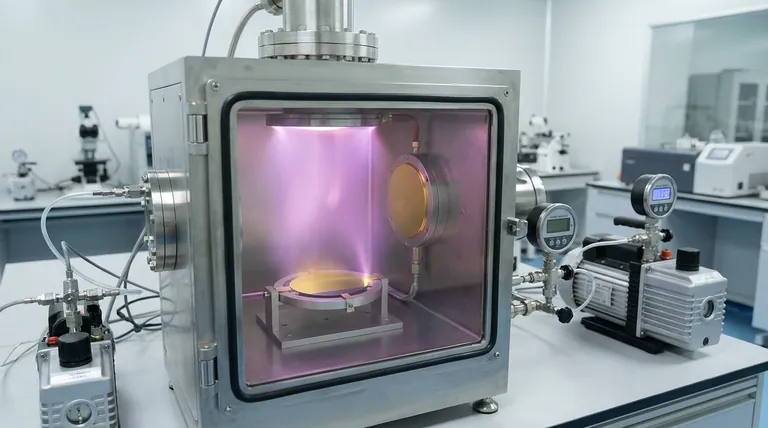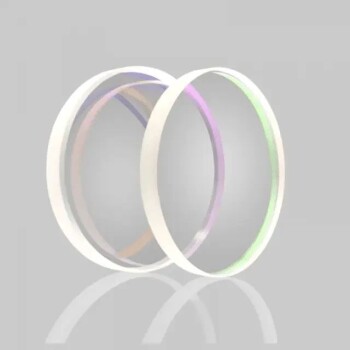In essence, gold sputtering is a highly controlled physical vapor deposition (PVD) process used to apply an exceptionally thin and uniform layer of gold onto a surface. It works by bombarding a solid gold source, known as a target, with energetic ions in a vacuum. This impact ejects gold atoms, which then travel and deposit onto a nearby object, called the substrate, forming the desired coating.
Gold sputtering is not merely a method for coating; it is a precision engineering technique. It uses the momentum transfer from ionized gas to create high-purity, functional gold films with specific, controllable properties like conductivity or reflectivity.

The Mechanics of Sputtering: From Plasma to Film
The sputtering process is a carefully orchestrated sequence of events that takes place within a specialized vacuum chamber. Understanding each step is key to appreciating its precision.
Creating the Vacuum Environment
The entire process begins by placing the target (the gold source) and the substrate (the item to be coated) into a sealed chamber. This chamber is evacuated to create a high vacuum, after which a small, controlled amount of an inert gas, most commonly Argon, is introduced.
Igniting the Plasma
A high voltage is applied within the chamber, creating a strong electric field between the target and the substrate. This energy strips electrons from the Argon atoms, creating a glowing, electrically charged gas known as a plasma. In this state, the chamber contains free electrons and positively charged Argon ions.
Ion Bombardment
The gold target is given a negative electrical charge (making it a cathode). This causes the positively charged Argon ions from the plasma to accelerate and collide with the gold target at high velocity.
Ejection and Deposition
The force of these collisions is powerful enough to physically knock out, or "sputter," individual atoms from the gold target. These ejected gold atoms travel in a vapor stream across the chamber and land on the substrate, gradually building up an atomic-level thin film.
Key Applications of Gold Sputtering
The unique properties of gold—its conductivity, inertness, and reflectivity—make sputtered films invaluable across several advanced industries.
Electronics and Semiconductors
Gold's excellent electrical conductivity and resistance to oxidation make it a premier choice for coating critical electronic components. It is used to create reliable contacts, wires, and conductive layers on circuit boards and within semiconductor devices.
Medical and Life Sciences
In medicine, sputtered gold films serve two primary purposes. They can coat biomedical implants to make them radiopaque, or visible in X-rays, and their inert nature ensures biocompatibility. For researchers, sputtering is essential for preparing non-conductive samples, such as biological tissue, for viewing under a Scanning Electron Microscope (SEM).
Optics and High-End Goods
Gold's high reflectivity is leveraged in the optics industry to create specialized mirrors and reflective coatings. In the luxury goods sector, the process provides a durable, uniform, and brilliant gold finish for high-end watches and jewelry.
Understanding the Process Parameters
The quality and characteristics of the final sputtered film are not accidental; they are the result of precise control over several key variables.
The Role of Gas and Pressure
The type of inert gas used and the pressure inside the chamber directly influence the efficiency of the sputtering process. Argon is a common choice because its mass is well-suited for effectively dislodging gold atoms.
The Impact of Energy
The voltage applied determines the kinetic energy of the bombarding ions. Higher energy leads to a faster deposition rate but can also affect the final structure of the film. Controlling this energy is critical to achieving the desired outcome.
Control Over Film Properties
Sputtering offers unparalleled control over the final coating. By adjusting process parameters, technicians can precisely manage the film's thickness, density, adhesion, and even its grain structure. This allows for the creation of films tailored to very specific functional requirements.
Making the Right Choice for Your Goal
Deciding to use gold sputtering depends entirely on the specific properties you need to achieve in the final product.
- If your primary focus is high-performance electronics: Sputtering is the superior method for creating dense, highly conductive, and corrosion-resistant gold layers for mission-critical components.
- If your primary focus is biocompatibility and medical imaging: The purity and inertness of a sputtered gold film make it an ideal choice for medical devices that will be implanted or used for diagnostic imaging.
- If your primary focus is precision sample preparation: For high-resolution microscopy (SEM), gold sputtering provides the essential conductive coating needed for clear imaging without damaging the delicate sample.
Ultimately, gold sputtering is a powerful tool for engineering materials at the atomic scale, enabling performance and functionality that would otherwise be impossible.
Summary Table:
| Key Aspect | Description |
|---|---|
| Process | Physical Vapor Deposition (PVD) using ion bombardment in a vacuum. |
| Primary Use | Applying thin, uniform, and highly functional gold films. |
| Key Industries | Electronics, Medical Devices, Life Sciences, Optics. |
| Main Benefits | High purity, excellent conductivity, strong adhesion, precise control over film properties. |
Need a high-performance gold coating for your application?
KINTEK specializes in precision lab equipment and consumables for sputtering and other PVD processes. Whether you are developing advanced semiconductors, medical implants, or require reliable sample preparation for microscopy, our solutions ensure the consistent, high-quality results you need.
Contact our experts today to discuss how we can support your laboratory's specific coating requirements.
Visual Guide

Related Products
- Chemical Vapor Deposition CVD Equipment System Chamber Slide PECVD Tube Furnace with Liquid Gasifier PECVD Machine
- Inclined Rotary Plasma Enhanced Chemical Vapor Deposition PECVD Equipment Tube Furnace Machine
- Microwave Plasma Chemical Vapor Deposition MPCVD Machine System Reactor for Lab and Diamond Growth
- RF PECVD System Radio Frequency Plasma-Enhanced Chemical Vapor Deposition RF PECVD
- Electron Beam Evaporation Coating Oxygen-Free Copper Crucible and Evaporation Boat
People Also Ask
- How is PECVD different from CVD? Unlock Low-Temperature Thin Film Deposition
- What is the difference between thermal CVD and PECVD? Choose the Right Thin-Film Deposition Method
- What are the advantages of PECVD over CVD? Achieve High-Quality Thin Films at Lower Temperatures
- What are the examples of CVD method? Discover the Versatile Applications of Chemical Vapor Deposition
- How plasma is generated in PECVD? A Step-by-Step Breakdown of the Process


















